Neuroscience For Kids
Ecstasy

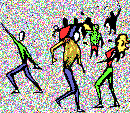
What is Ecstasy (MDMA)?
The American Heritage Dictionary defines ecstasy as "intense joy or delight." Despite its peppy name, the illegal drug ecstasy can damage nerve cells in the brain. Ecstasy, also known as 3,4 methylenedioxymethamphetamine or "MDMA" for short, is a stimulant related to the drugs mescaline and amphetamine. Other names for MDMA are "Adam," "XTC," "Doves" or just "E."
MDMA was first synthesized and patented in 1914 by Merck, a German drug company. Scientists thought that this drug could be used as an appetite suppressant. In the 1970s, MDMA was given to psychotherapy patients because it helped them talk about their feelings. This practice was stopped in 1986 when animal studies showed that ecstasy caused brain damage.
Behavioral Effects of MDMA
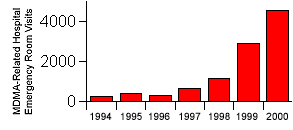 Some users say they take ecstasy because it lowers their inhibitions
and relaxes them. MDMA is also said to increase awareness and feelings of
pleasure and to give people energy. However, some people report side
effects after taking MDMA such as headaches, chills, eye twitching, jaw
clenching, blurred vision and nausea. Some doses of MDMA can cause
dehydration, hyperthermia and seizures. The effects of MDMA send some
people to the emergency room (see graph on right). Unlike the drug LSD, MDMA in low doses does not cause people to
hallucinate. Ecstasy gained national attention when it was the drug of
choice at club parties, called "raves." In a survey taken in 2019, 2.2%
of 12th graders, 1.7% of 10th graders and 1.1% of 8th graders reported
that they had used MDMA at least once within the year.
Some users say they take ecstasy because it lowers their inhibitions
and relaxes them. MDMA is also said to increase awareness and feelings of
pleasure and to give people energy. However, some people report side
effects after taking MDMA such as headaches, chills, eye twitching, jaw
clenching, blurred vision and nausea. Some doses of MDMA can cause
dehydration, hyperthermia and seizures. The effects of MDMA send some
people to the emergency room (see graph on right). Unlike the drug LSD, MDMA in low doses does not cause people to
hallucinate. Ecstasy gained national attention when it was the drug of
choice at club parties, called "raves." In a survey taken in 2019, 2.2%
of 12th graders, 1.7% of 10th graders and 1.1% of 8th graders reported
that they had used MDMA at least once within the year.
Effects of MDMA on the Brain
MDMA appears to have several effects on the brain. MDMA can:
- cause the release of the neurotransmitter called serotonin.
- block the reuptake of serotonin by the synaptic terminal that releases it.
- deplete the amount of serotonin in the brain.
| Normal Synapse | Effect of MDMA |
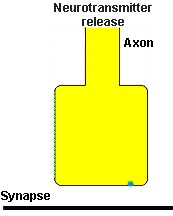 | 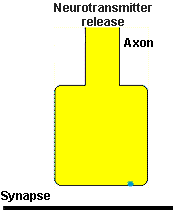 |
 Data suggest that MDMA may be toxic to the brain. Dr. George Ricaurte, an
associate professor of neurology at Johns Hopkins University, analyzed
brain scans of people who had used ecstasy. The study included people who
had used ecstasy an average of 200 times over five years. Although the
behavior of these people appeared normal, brain scans showed that the drug
had damaged their brains. In fact, those who used the drug more often had
more brain damage than less frequent users. Moreover, memory tests of
people who have taken ecstasy as compared to non-drug users have shown
that the ecstasy users had lower scores.
Data suggest that MDMA may be toxic to the brain. Dr. George Ricaurte, an
associate professor of neurology at Johns Hopkins University, analyzed
brain scans of people who had used ecstasy. The study included people who
had used ecstasy an average of 200 times over five years. Although the
behavior of these people appeared normal, brain scans showed that the drug
had damaged their brains. In fact, those who used the drug more often had
more brain damage than less frequent users. Moreover, memory tests of
people who have taken ecstasy as compared to non-drug users have shown
that the ecstasy users had lower scores.
Specifically, the drug damaged cells that release the neurotransmitter called serotonin. Using an imaging technique called positron emission tomography (PET), Ricaurte noted a 20-60% reduction in healthy serotonin cells in the drug users. Damage to these cells could affect a person's abilities to remember and to learn.
At this point, scientists do not know if this damage is permanent, or if those damaged cells will replace themselves. Also, it is not known if this loss of cells affects behavior or the ability to think. Ricaurte is conducting other studies to gauge ecstasy's effect on mood, memory, cognition, and behaviors such as eating and sleeping. In 2003, German researchers used PET scans to study the brains of current and past users of ecstasy. This research demonstrated that ecstasy users had lower levels of serotonin activity in several brain areas. However, ecstasy users who stopped using the drug 20 weeks before the scan showed some recovery in serotonin function.
Information from brain scans of people is valuable, but it is difficult to control the different variables when using human subjects. Perhaps some of the students didn't report their drug use accurately. Maybe they didn't remember how many times they had used ecstasy. To be able to control the variables more carefully in a study, Ricaurte looked for help from animal experiments. In an article published in The Journal of Neuroscience (June 15, 1999), Ricaurte compared the data from monkeys who were given ecstasy dissolved in a liquid twice a day for four days to other monkeys who received the same liquid WITHOUT the ecstasy twice a day for four days. The study showed that the monkeys who were given ecstasy had damage to the serotonin-containing nerve cells. This damage was still visible seven years later!. Areas that were especially affected were the frontal lobe of the cerebral cortex, an area in the front part of the brain that is used in thinking, and the hippocampus, an area deep in the brain that helps with memory. Although damage was still observed seven years later, it was less severe than when it was observed two weeks after drug use. This suggests that some regrowth could have occurred, but that it is far from complete.
Effect of MDMA on serotonin neurons in the monkey
brain.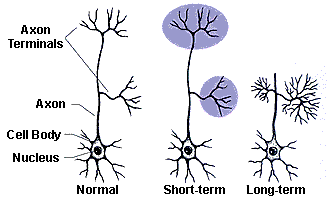
Image courtesy of the
National Institute on Drug
Abuse.
Effect of MDMA on serotonin neurons in the monkey
brain.
Image courtesy of the
National Institute on Drug
Abuse.
Now scientists must tease out what these results from monkeys mean to humans. Although the specifics are lacking, at this point, the evidence points to loss of memory and cognitive ability among ecstasy users.
 Hear It!
Hear It!
 Did you know?
Did you know?
In 2002, Dr. Ricaute published a paper in Science that showed neurotoxic effects of MDMA on neurons that use the neurotransmitter called dopamine. However, he had to retract this paper when he found out that the drug he gave to monkeys and baboons was methamphetamine, not MDMA.
References and more information about MDMA:
- Schenk, S., MDMA (ecstasy) abuse as an example of dopamine neuroplasticity, Neuroscience & Biobehavioral Reviews, 35:1203-1218, 2011.
- Hatzidimitriou, G., McCann, U.D. and Ricaurte, G.A. Altered serotonin innervation patterns in the forebrain of monkeys treated with (+/-)3,4-methylenedioxymethamphetamine seven years previously: factors influencing abnormal recovery. J. Neurosci., 19:5096-107, 1999.
- Buchert, R., Thomasius, R., Nebeling, B., Petersen, K., Obrocki, J., Jenicke, L., Wilke, F., Wartberg, L., Zapletalova, P. and Clausen, M. Long-term effects of "ecstasy" use on serotonin transporters of the brain investigated by PET. J Nucl Med, 44:375-384, 2003.
- Ecstasy Infofax - National Institute on Drug Abuse
- Ecstasy and the Heart - Neuroscience for Kids
- How Molly Works in the Brain
Copyright © 1996-2017, Eric H. Chudler All Rights Reserved.
